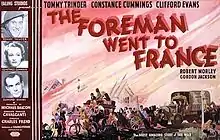The Foreman Went to France
The Foreman Went to France (released in the USA as Somewhere in France [2]) is a 1942 British Second World War war film starring Clifford Evans, Tommy Trinder, Constance Cummings and Gordon Jackson. It was based on the real-life wartime exploits of Welsh munitions worker Melbourne Johns, who rescued machinery used to make guns for Spitfires and Hurricanes.[3][4] It was an Ealing Studios film made in 1941 with the support of the War Office and the Free French Forces. All of the 'heroes' are portrayed as ordinary people caught up in the war.[5]
| The Foreman Went to France | |
|---|---|
 Original UK quad format poster | |
| Directed by | Charles Frend |
| Produced by | Michael Balcon |
| Screenplay by | Leslie Arliss John Dighton Angus MacPhail |
| Story by | J. B. Priestley |
| Starring | Clifford Evans Tommy Trinder Constance Cummings Gordon Jackson |
| Music by | William Walton |
| Cinematography | Wilkie Cooper |
| Edited by | Robert Hamer |
Production company | |
| Distributed by | United Artists Ltd (UK)[1] |
Release date |
|
Running time | 87 minutes [1] |
| Country | United Kingdom |
| Language | English |
Plot
In 1942, Welsh armaments factory foreman,Fred Carrick (Clifford Evans), goes to Bivary in France on his own initiative to retrieve three large pieces of machinery for making cannon for Spitfires. Critically these must be removed ahead of the German army reaching the town. In Bivary , he requests the aid of two soldiers (Tommy Trinder, Gordon Jackson) and more importantly, their army lorry. He also gets the help of the company secretary in France, an American woman (Constance Cummings), who needs to go north to find her sister who is a nurse.
While in France, he learns about the rôle of the fifth column, and that even those in positions of authority such as the town mayor (Robert Morley) cannot always be trusted. During the race to the coast with the machines, he encounters a huge number of refugees fleeing the advancing Nazis and many more obstacles to halt his progress. They take half a dozen orphaned children on their journey. Tommy Trinder entertains the children with his humorous songs.
Cast
- Clifford Evans as Fred Carrick, the foreman
- Tommy Trinder as Tommy Hoskins
- Constance Cummings as Anne Stafford the American
- Robert Morley as Mayor Coutare of Bivary
- Gordon Jackson as Alastair 'Jock' MacFarlane
- Ernest Milton as the stationmaster in La Tour
- Charles Victor as the aircraft spotter on the Works roof
- John Williams as the 'English' army captain
- Paul Bonifas as the Prefect of Rouville
- Anita Palacine as a La Tour barmaid
- Francis L. Sullivan as a French skipper
- Mervyn Johns as Official, Passport Office
- Sidney Adams as Driver
- Owen Reynolds as Collins, Burns & Fawcett Works Manager
- Ronald Adam as Sir Charles Fawcett, Managing Director in Wales
- Eric Maturin as Older Man (uncredited)
Reception
Dr. Keith M. Johnston, lecturer in Film & Television Studies at the University of East Anglia, described it as "a strange little propaganda piece, a flashback-structured film that dramatises the 'true' story of Melbourne Johns ... Overall, this is a nicely done little film, but it survives largely because of a committed cast and some strong narrative elements."[4]
References
- BBFC: The Foreman Went to France - Distributor(s) United Artists Corp. Ltd Linked 6 December 2015
- Slide, Anthony: Some Joe You Don't Know: An American Biographical Guide to 100 British Television Personalities, page 124, Greenwood Publishing Group, 1996 Linked 6 December 2015
- Duncan Higgitt. "War hero out of oblivion". WalesOnline.co.uk. Retrieved 1 August 2008.
- Dr. Keith M. Johnson (5 March 2012). "The Great Ealing Film Challenge 50: The Foreman Went to France (1942)". HuffPost.
- Judith Cook, Priestley, London: Bloomsbury, 1997, p. 179